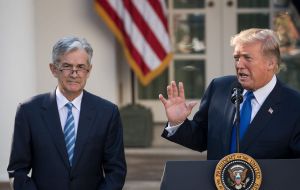MercoPress. South Atlantic News Agency
Fed raises interest rate but lowers 2019 forecast to two hikes in 2019
 “The economy has continued to perform well,” Fed Chairman Jerome Powell said at a news conference
“The economy has continued to perform well,” Fed Chairman Jerome Powell said at a news conference  The move, which comes amid President Trump’s repeated criticism of Fed rate hikes, is expected to set off a domino effect across the US economy
The move, which comes amid President Trump’s repeated criticism of Fed rate hikes, is expected to set off a domino effect across the US economy The United States Federal Reserve raised its key interest rate on Wednesday for a fourth time this year but lowered its forecast to two hikes in 2019 amid the recent stock market sell-off and uncertain growth prospects.
“The economy has continued to perform well,” Fed Chairman Jerome Powell said at a news conference. But, he added, “We have seen developments that may signal some softening ... In early 2018, we saw a rising trajectory for growth. Today, we see growth moderating ahead.”
The central bank’s latest move, which comes amid President Donald Trump’s repeated criticism of Fed rate hikes, is expected to set off a domino effect across the US economy, bumping up rates on credit cards, home equity lines of credit and adjustable-rate mortgages.
As expected, the Fed raised the federal funds rate – which is what banks charge each other for overnight loans – by a quarter point to a range of 2.25 to 2.5%. It marked the central bank's ninth hike since late 2015.
But in a statement after a two-day meeting, the Fed acknowledged a slowdown in global economic growth, the stock market’s plunge and a strong dollar that’s making U.S. exports more expensive for overseas customers.
The Fed “will continue to monitor global economic and financial developments and assess their implications for the economic outlook,” the statement said.
Fed officials also indicated they foresees fewer rate hikes next year, estimating that only “some gradual increases” will be warranted. The wording change reflects a central bank that now intends to respond in real time to the course the economy takes rather than follow a rate-hike road map as it has the past couple of years.
”Weaker-than-expected data, both in the United States and/or in major foreign economies, could derail further rate hikes, at least for the foreseeable future,“ Wells Fargo economist Jay Bryson wrote in a note to clients.
Despite the Fed's market-friendly expectation for fewer rate hikes, the Dow Jones Industrial Average fell 352 points, or 1.5 percent.
Fed officials are grappling with conflicting forces. On the one hand, the unemployment rate has fallen to a 49-year low of 3.7% – traditionally a signal of faster wage growth and inflation.
At the same time, federal tax cuts and spending increases that juiced economic growth this year are set to begin fading in 2019. The Trump administration’s trade war with China is likely to take a bigger toll on the economy. And the Fed rate hikes themselves are expected to curtail consumer and business borrowing.
”Political comments have played no role whatsoever in our decisions or discussions on monetary policy,” Powell said on Wednesday, noting the Fed is an independent agency.
The Fed cut its forecast from three hikes next year to two. Amid the uncertain economy, markets have anticipated just one rate increase in 2019.
Fed officials expect the key rate to rise to 2.9% at the end of 2019, and 3.1% at the end of 2020, down from 3.1% and 3.4%, respectively, in their September projection.
The FOMC December 19 release
Information received since the Federal Open Market Committee met in November indicates that the labor market has continued to strengthen and that economic activity has been rising at a strong rate. Job gains have been strong, on average, in recent months, and the unemployment rate has remained low. Household spending has continued to grow strongly, while growth of business fixed investment has moderated from its rapid pace earlier in the year. On a 12-month basis, both overall inflation and inflation for items other than food and energy remain near 2 percent. Indicators of longer-term inflation expectations are little changed, on balance.
Consistent with its statutory mandate, the Committee seeks to foster maximum employment and price stability. The Committee judges that some further gradual increases in the target range for the federal funds rate will be consistent with sustained expansion of economic activity, strong labor market conditions, and inflation near the Committee's symmetric 2 percent objective over the medium term. The Committee judges that risks to the economic outlook are roughly balanced, but will continue to monitor global economic and financial developments and assess their implications for the economic outlook.
In view of realized and expected labor market conditions and inflation, the Committee decided to raise the target range for the federal funds rate to 2-1/4 to 2 1/2 percent.
In determining the timing and size of future adjustments to the target range for the federal funds rate, the Committee will assess realized and expected economic conditions relative to its maximum employment objective and its symmetric 2 percent inflation objective. This assessment will take into account a wide range of information, including measures of labor market conditions, indicators of inflation pressures and inflation expectations, and readings on financial and international developments.
Voting for the FOMC monetary policy action were: Jerome H. Powell, Chairman; John C. Williams, Vice Chairman; Thomas I. Barkin; Raphael W. Bostic; Michelle W. Bowman; Lael Brainard; Richard H. Clarida; Mary C. Daly; Loretta J. Mester; and Randal K. Quarles.




Top Comments
Disclaimer & comment rulesCommenting for this story is now closed.
If you have a Facebook account, become a fan and comment on our Facebook Page!